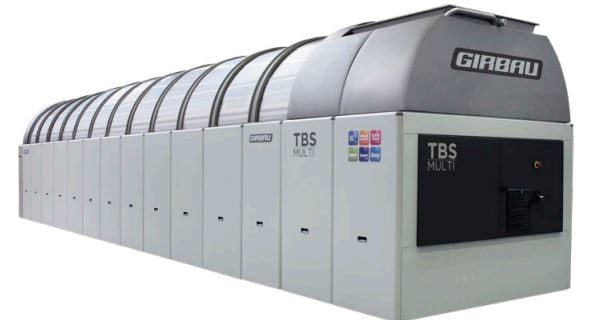
There are several types of classification of tunnel washers, depending on the method used to move the water and linen.
2.1 .- Depending on the movement of water
Tunnel washers can be classified according to how the water moves in the washing phases: with the flow, against the flow and/or static. The part of the tunnel washer where the rinsing phase takes place works with a counter-flow water movement.
– Counter-flow water movement: The dirty linen enters at the head of the tunnel washer, while the water enters at the rinsing area at the end of the tunnel, and the linen moves towards increasingly clean modules, while the water moves in the opposite direction to the linen, towards increasingly dirty chambers. - With-flow water movement: Both the dirty linen and the water for treating it enter at the head of the tunnel washer, and the water moves toward the exit in the same direction as the loads of linen, depending on the system for moving the linen (bottom or central transfer) used by the tunnel washer uses, with a greater or lesser amount of water advancing together with the linen.
– Static washing phases: The linen and detergent bath (water, detergent and dirt) are fed into the first chamber of the phase (the wash phase) and remain together until the end of phase.
Method for moving the linen
Depending on the method used to move linen between the different chambers, continuous linen washers can be classified as:
2.2.1- “Bottom transfer tunnel washers”: In “bottom transfer” machines the action of moving the linen from one compartment to the next occurs by an Archimedes screw action, with the transfer from one chamber to the next taking place at the bottom. The bottom-transfer system has a smaller transfer aperture, thus requiring large drum diameters, since the transfer takes place at the perimeter. There is a higher risk of clogging with this type of tunnel washer.
The design of a “bottom transfer” tunnel washer is conditioned by the need to achieve enough energy for the transfer.
2.2.2.- “Top Transfer” tunnel washers: With the top transfer system a transferring blade raises the linen to the top of the cylinder, leaving it to drop down into the next chamber.
Raising the linen provides a high enough speed and a considerable degree of transfer energy that enables the linen to be transferred to the next chamber through the transfer aperture. This greater potential transfer energy greatly reduces the risk of clogging in such tunnel washers.
2.3 .- Depending on the type of rotation used in the tunnel washer:
And lastly, a distinction can also be drawn between tunnel washers that operate with a full rotation and those that operate with drums rotating in alternate directions.
Each of the systems favours one type of mechanical action over the other. A full rotation tunnel washer develops a powerful mechanical action but can be too aggressive in many cases, whereas a tunnel washer with an oscillating drum represents a much more controlled mechanical action, since it is possible to program the angle of rotation.
Newmatic 2017. All Rights Reserved
Website Design By Newmatic
Comments
Add Comment